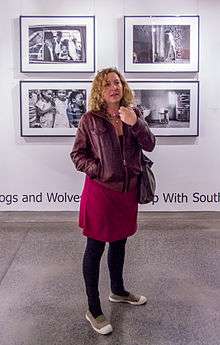Jodi Bieber
Jodi Bieber (born 1966)[1] is a South African photographer. Her photograph of Bibi Aisha, a woman from Afghanistan whose ears and nose were severed by her husband and brother-in-law, was selected as the World Press Photo of the Year in 2010.[2]
Jodi Bieber | |
|---|---|
 Jodi Bieber in 2014 | |
| Born | 1966[1] Johannesburg, South Africa[1] |
| Awards | 2010 World Press Photo of the Year[2] |
| Website | www |
Early life and work
Bieber was born in 1966 in Johannesburg.[1] In the early 1990s she attended David Goldblatt's Market Photo Workshops and covered the 1994 South African general election, South Africa's first democratic elections, for The Star.[3] She trained under Ken Oosterbroek in 1993 and worked in South Africa until 1996.[4] In 2000 she covered an ebola outbreak in Uganda for The New York Times Magazine.[5]
Approach to photography
Bieber has said that her work is not photojournalism: "I do not aspire to objectivity. I'm simply a photographer. I show what I see and what strikes me, always from my point of view."[3]
Bibi Aisha
Bibi Aisha, then 18, was disfigured after being convicted by the Taliban of taking refuge from a violent husband in her family home. Her story was part of a 2010 Time report into the conditions of Afghan women (see Women's rights in Afghanistan), in conjunction with which Bieber's photo was featured on the magazine's front cover. David Burnett, the chair of the World Press Photo (WPP) jury, said of Bieber's photo of Aisha, "This could become one of those pictures – and we have maybe just ten in our lifetime – where if somebody says, 'You know, that picture of a girl … ', you know exactly which one they're talking about." The Photo of the Year award was Bieber's tenth WPP prize.[6]
Speaking about the photograph, Bieber said "I could have made a photograph with her looking or being portrayed more as the victim. And I thought 'no, this woman is beautiful.'"[7] In a 2014 essay Hilary Janks discussed Bieber's concern for Aisha's beauty and questioned whether "the mutilation [would] have been less reprehensible if Aisha had not been young and beautiful".[8]
Other work
Bieber's book Soweto depicting contemporary scenes from the township of Soweto in Johannesburg, was published in 2010.[9][10] Bieber described the book as an attempt to counter stereotypes about Soweto and to rectify the absence of representations of post-Apartheid Soweto.[9][10]
During the lockdown imposed in response to the COVID-19 pandemic in South Africa, Bieber published on Instagram a series of photographs of her husband Francois in various costumes.[11]
Publications
- Between Dogs and Wolves: Growing up with South Africa. Stockport: Dewi Lewis, 1996. ISBN 978-1904587323.
- Soweto. Jacana, 2010. ISBN 978-1770098060. With an introduction by Niq Mhlongo.[9]
- Real Beauty. 2014. Pagina, Goch/Germany, 2014. ISBN 978-3-944146-11-9.
References
- Phillips, Sarah (20 November 2011). "Photographer Jodi Bieber's best shot". The Guardian. Retrieved 22 June 2012.
- "2011 Photo Contest, World Press Photo of the Year". World Press Photo of the Year. Retrieved 19 May 2020.
- Ragusa, Stefania (29 December 2017). "The South Africa of Jodi Bieber. Between Darkness and Light". Doppiozero. Retrieved 19 May 2020.
- Dunlap, David W. (11 February 2011). "Is This the Best News Picture in the World?". Retrieved 19 April 2015.
- Laurent, Olivier (29 July 2014). "Picturing Ebola: Photographers Chase an Invisible Killer". Time. Retrieved 19 April 2015.
- "World Press Photo 2011 in Edinburgh – Jodi Bieber interview". The List. 8 July 2011. Retrieved 19 April 2015.
- "Photographing Aisha for the Cover of TIME". Time. Retrieved 19 April 2015.
- Janks, Hilary (2014). "The Importance of Critical Literacy". In Pandya, Jessica Zacher; Ávila, JuliAnna (eds.). Moving Critical Literacies Forward: A New Look at Praxis Across Contexts. New York: Routledge. p. 36.
- Laurent, Olivier (30 May 2010). "Jodi Bieber's Soweto". British Journal of Photography. Archived from the original on 31 May 2013. Retrieved 19 April 2015.
- Johnson, Whitney (1 July 2010). "Postcard from Soweto: Jodi Bieber". The New Yorker. Retrieved 19 May 2020.
- Bainbridge, Simon (16 April 2020). "Evidence of Work: Jodi Bieber's playful images of her husband in lockdown". British Journal of Photography. Retrieved 19 May 2020.
External links
- Official website
- Baker, Aryn (9 August 2010). "Afghan Women and the Return of the Taliban". Time – the cover story which Bieber's photograph of Aisha accompanied
- Nordland, Rod (4 August 2010). "Portrait of Pain Ignites Debate Over Afghan War". The New York Times – article concerning the international response to the Time cover